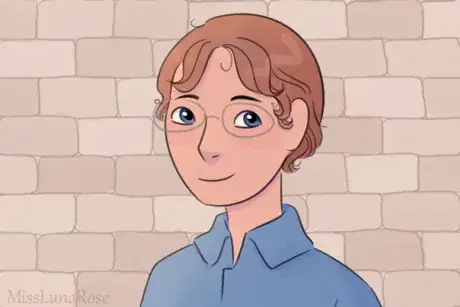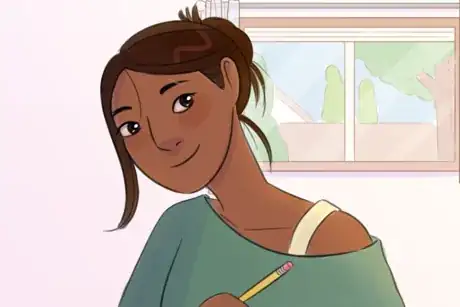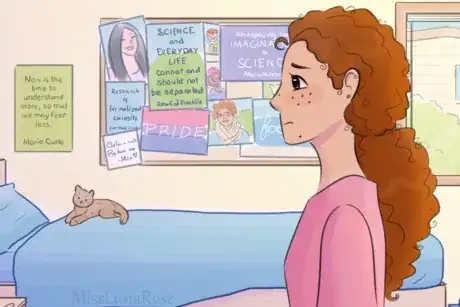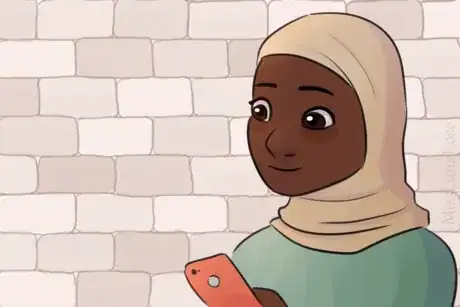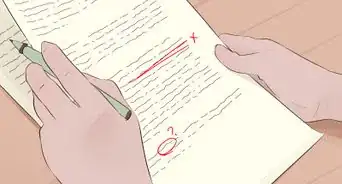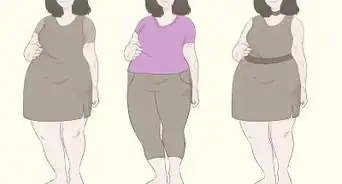This article was co-authored by Grant Faulkner, MA. Grant Faulkner is the Executive Director of National Novel Writing Month (NaNoWriMo) and the co-founder of 100 Word Story, a literary magazine. Grant has published two books on writing and has been published in The New York Times and Writer’s Digest. He co-hosts Write-minded, a weekly podcast on writing and publishing, and has a M.A. in Creative Writing from San Francisco State University.
There are 8 references cited in this article, which can be found at the bottom of the page.
This article has been viewed 60,058 times.
Writing a main female character can be challenging, especially when there are so many cliches around female characters and representing women in works of fiction. You may struggle to create a female character who is nuanced, detailed, and realistic for your novel, short story, or screenplay. You can tackle this writing challenge successfully by focusing on creating a main female character that is developed, has agency, and is strong in her own way. You can then polish the main female character though revision and edits to ensure the character is believable to others.
Steps
Brainstorming the Main Female Character
-
1Try using a woman in your life as a role model. To get ideas for your main female character, you may draw on the women in your life. Think about female role models like your mother, an aunt, a sister, a teacher, an employer, or a female friend. You may be inspired by the strength of the women in your life and use one of them or a combination of them for your character.[1]
- For example, if you are trying to find a model for a main female character who is a teenager, you may talk to your mother about her life as a teenager or draw on your sister's experience of being a teenager.
-
2Draw on your own experiences of women. If you are a woman, you may think about your own personal experiences. Think about how it feels to walk around in the world in your body and how your gender shapes your perspective. If you are not female, you may think about the women you have interacted with in the past or in the present. Consider how you can depict the women you know accurately on the page.[2]
- If you are not female, you may find it challenging to draw on the experiences of a gender that is not your own. Focus on how you view the women around you from your perspective and get inspiration for your character that way.
- You can also read articles written by women about what their experiences are like.
Advertisement -
3Design her as a character who suits your story, not just a "female character." Her gender is one part of her, but unless it's key to your story, it's not the most important part of her role. Think about the role that needs filling in your story.
- What skills does your character need to accomplish the things the plot will demand of her?
- What flaws and baggage could raise the stakes and make this harder for her?
- What's your theme? How should her story reflect this?
-
4Create a backstory for your character. Once you have an idea in mind for your main female character, you should write out a backstory for your character. Give the female character unique personality traits and quirks. She should have a list of hobbies, interests, and beliefs that make her a well rounded character. Create a backstory for her that is nuanced and engaging.[3]
- For example, perhaps your character is interested in politics, though she is still in high school. She may aspire to be the first female president. She may focus on social justice issues in her community.
- Or, perhaps you have a female character who is struggling with her identity and trying to fit into a friend group in college. You might also give her an interesting hobby like archery that involves mental and physical skill.
-
5Read examples of main female characters.[4] You can also look at published writing that does a good job of representing women on the page. You may read writing by primarily female writers to get some inspiration or read great writing in general. For example, you may read:[5]
- Pride and Prejudice by Jane Austen
- The Bluest Eye by Toni Morrison
- The Color Purple by Alice Walker
- The House on Mango Street by Sandra Cisneros
- Mrs. Dalloway by Virginia Woolf
- The Outlander Series by Diana Gabaldon
Writing the Main Female Character
-
1Plan her character arc. In most good stories, the main character changes over the course of the plot, learning and growing. Let her struggle, and learn from it. Let her become a better, stronger person as a result.
- While men could be involved in her character arc, try to choose something that isn't based solely around a man.
- If your story is a tragedy, the character may not learn and grow, thus failing to learn the necessary lesson (or, learning it too late) and getting an unhappy ending.
-
2Give the character agency. One of the key ways to give your main female character depth is to give her agency. This means the character should be a key participant in the plot of the novel. She should exist for herself, not as a mirror or a victim to other characters, especially male characters. Give the character a full sense of self and allow her to exist in an active way in the story.[6]
- If your character could be replaced by a sexy lamp with a note attached to it, and the plot wouldn't change much, then she does not have enough agency.[7]
- Choose some goals for her to pursue during the story. Her goals could be related to her career, relationships, hobbies, personal development, or something else. She should take meaningful action towards these goals.
- While she may have children or a relationship with a man, give her some goals unrelated to caring for or pleasing other people.
-
3Give her something positive to contribute. A strong, likable character has skills that let them improve the world around them.[8] Your main character should positively impact the people and/or environment around her in some way. This can be through both traditional "skills" (like engineering or martial arts) and through traits like kindness and empathy.
- This doesn't mean they need to be a human Swiss Army knife. Instead, focus on a few skills, and remember she doesn't have to be the best of all time to be useful. She just needs to show competence and be useful somehow. (Even child characters can be helpful by being kind and cheering up other characters.)
-
4Allow the character to have flaws and vulnerabilities. To make your main female character relatable, she should have flaws. Avoid the perfect image of a woman when writing, as this often objectifies the female character and makes them appear flat. Instead, be willing to give your character flaws or issues that she is grappling with in your narrative. This will often deepen the female character and make her feel more genuine.
- For example, maybe you have a female character who is physically strong while also dealing with an anxiety disorder and stage fright. Seeing her grapple with these difficulties will help readers relate to her and cheer her on as she struggles to achieve her goals.
Tip: A real flaw isn't just something superficial like being clumsy or cutely shy. Your character's thoughts and behavior should hold her back in some way with real consequences for her.[9] It should be a struggle to overcome.
-
5Avoid cliche descriptions of women. When you are writing the female character, you should be aware of the cliches that exist about female characters in writing and work hard to avoid them. Describing a female character with physical traits like “pretty”, “petite”, “bosomy” or “hot”, can be cliche and often flattens your character so they are one dimensional on the page. Rather than resort to cliches, try to come up with nuanced ways of describing your female character.[10]
- It's okay to write a pretty character, but skip the gratuitous descriptions of her figure.
- For example, you may describe your main female character by focusing on her actions rather than her physical attributes. You may talk about her in terms of her critical thinking, her ability to speak her mind, and her sense of humor, rather than focus on her body shape or appearance.
-
6Include more than one major female character in the story if possible. Another way you can deepen your main female character is to have more than one female character in your story so they can interact and talk. Having more than one female character will also show readers that you are not tokenizing one woman and are willing to include several female voices in your writing.
- The bare minimum is whether the story passes the Bechdel test. A story passes the Bechdel test if it has (1) at least two named female characters who (2) have a conversation with each other (3) about something other than a man or men.
- One issue with female characters in fiction is there being only one major female character, and thus the writers feel the need to make her incredibly smart and strong because she represents her entire gender. If you have a variety of female characters, you can make them feel more real, with strengths and weaknesses.
-
7Give all your main characters similar depth.[11] Your main female character should be at least as detailed and nuanced as the other main characters in your story. Regardless of gender, you should strive to create characters that will linger in the reader's mind and feel unique. Do not limit your main female character just because she is female. She should have all the qualities of a strong character and stand on her own in your story.
- Look at your other main characters and consider if they are more developed than your main female character. Do they have more aspirations, goals, and wants than your main female character? Do they feel more unique and nuanced than your main female character? If the answer to these questions are "yes," you may need to go back and rethink your main female character.
-
8Research things you don't fully understand from personal experience. Your main character's life will be different from yours in plenty of ways. If it's pretty different, then learn about it. Read articles, books, blog posts, and whatever helps. This helps your writing make sense and feel true to readers who have had these experiences themselves.
- Don't just rely on scientific sources when it comes to illnesses and disabilities. While these are good to read, you should also read written works by people who have these conditions. They can more accurately describe how daily life feels.
- If her membership in a minority group is important to the story, read some things written by members of that group. What are their lives like? What do they wish people understood about them? Even if you're in that minority too, it might help to hear insights from your peers within the group.
Tip: Assume that your audience may include people who have lived through these things and people who know a lot about these things. For example, if your story discusses racism, assume that it will be read by minority readers and by experts who study racism. Research it well so you can say something true, helpful, and meaningful.
Polishing the Main Female Character
-
1Let women critique the female character. Once you have finished crafting the main female character, you should allow women around you to critique the character. Solicit feedback from female family and friends. Be willing to accept constructive criticism and listen to what others have to say.[12]
- Another option is to show the character to a writing group that has female members. Getting professional advice from female writers can help you avoid cliches and deepen your character.
- Women tend to see the world differently in some ways. For example, it might take a woman to tell you "no, she probably does not want to talk to that strange guy in the dark parking lot at night."
-
2Revise the character based on feedback.[13] Write down all the feedback you get from others on the character and then apply the feedback to the character. Revise the character with attention to her agency, her personality traits, and how she is described in your writing.
- You may try reading the main female character’s dialogue out loud to listen to how your character sounds. Your main female character should sound just as nuanced and detailed as any other character in your story.
-
3Consider how the character fits into the rest of your story. When you have a strong draft of your main female character, you should think about how the character fits into the rest of your story. You may place the main character within the plot outline for your novel and consider if she is an active part of the plot. You may have her interact with other characters in your novel and think about whether she is as nuanced and detailed as the other characters.[14]
- Think about how your female character embodies some of the themes in your story. For example, if you set out to write a story about empowerment, you may think about whether your main female character feels empowered and strong in your story.
Expert Q&A
-
QuestionWhat are some exercises I can try to give my characters more depth?
 Grant Faulkner, MAGrant Faulkner is the Executive Director of National Novel Writing Month (NaNoWriMo) and the co-founder of 100 Word Story, a literary magazine. Grant has published two books on writing and has been published in The New York Times and Writer’s Digest. He co-hosts Write-minded, a weekly podcast on writing and publishing, and has a M.A. in Creative Writing from San Francisco State University.
Grant Faulkner, MAGrant Faulkner is the Executive Director of National Novel Writing Month (NaNoWriMo) and the co-founder of 100 Word Story, a literary magazine. Grant has published two books on writing and has been published in The New York Times and Writer’s Digest. He co-hosts Write-minded, a weekly podcast on writing and publishing, and has a M.A. in Creative Writing from San Francisco State University.
Professional Writer Sometimes people put their characters through the lens of psychological profiles, such as determining whether they're extroverted or introverted. There's a bunch of different ways to explore your character, including character worksheets that you can download on the internet or get in books. I think the main thing is really to know what drives your character. Make sure your character isn't just a compilation of character descriptions or physical descriptions, but that they are a soul moving through the world.
Sometimes people put their characters through the lens of psychological profiles, such as determining whether they're extroverted or introverted. There's a bunch of different ways to explore your character, including character worksheets that you can download on the internet or get in books. I think the main thing is really to know what drives your character. Make sure your character isn't just a compilation of character descriptions or physical descriptions, but that they are a soul moving through the world. -
QuestionHow can a female make a cliche female?
 Community AnswerExamples of cliche females are: She hates all things girly, damsel in distress, the talented sidekick, the butt-kicking Asian, the sassy black friend. Try to avoid these and other standard female cliches.
Community AnswerExamples of cliche females are: She hates all things girly, damsel in distress, the talented sidekick, the butt-kicking Asian, the sassy black friend. Try to avoid these and other standard female cliches. -
QuestionI'm writing about a female character that loves to travel and graduated from high school this summer. What else can I add to make her a unique and strong female?
 MimiMarquezCommunity AnswerIt sounds like you have a very good outline for your character. Try to come up with a few more personality traits (such as witty, nervous, vain, logical etc.) and a detailed backstory in order to make her more flushed-out. If you want to add some representation, make her belong to a couple of minority groups - such as being Black or gay or autistic. Research some stereotypes for female characters and avoid them.
MimiMarquezCommunity AnswerIt sounds like you have a very good outline for your character. Try to come up with a few more personality traits (such as witty, nervous, vain, logical etc.) and a detailed backstory in order to make her more flushed-out. If you want to add some representation, make her belong to a couple of minority groups - such as being Black or gay or autistic. Research some stereotypes for female characters and avoid them.
References
- ↑ http://www.tor.com/2015/03/04/writing-women-characters-as-human-beings/
- ↑ http://www.tor.com/2015/03/04/writing-women-characters-as-human-beings/
- ↑ Grant Faulkner, MA. Professional Writer. Expert Interview. 8 January 2019.
- ↑ Grant Faulkner, MA. Professional Writer. Expert Interview. 8 January 2019.
- ↑ http://www.ranker.com/crowdranked-list/best-female-characters-in-literature
- ↑ http://www.tor.com/2015/03/04/writing-women-characters-as-human-beings/
- ↑ https://fanlore.org/wiki/Sexy_Lamp_Test
- ↑ https://misslunarose.home.blog/2019/05/24/why-readers-like-glitter/
- ↑ https://misslunarose.home.blog/2019/07/14/what-counts-as-a-character-flaw/
- ↑ http://www.writersdigest.com/writing-articles/by-writing-goal/improve-my-writing/5-steps-to-a-great-female-protagonist
- ↑ Grant Faulkner, MA. Professional Writer. Expert Interview. 8 January 2019.
- ↑ http://terribleminds.com/ramble/2015/02/16/how-strong-female-characters-still-end-up-weak-and-powerless-or-do-they-pass-the-action-figure-test/
- ↑ Grant Faulkner, MA. Professional Writer. Expert Interview. 8 January 2019.
- ↑ http://terribleminds.com/ramble/2015/02/16/how-strong-female-characters-still-end-up-weak-and-powerless-or-do-they-pass-the-action-figure-test/

